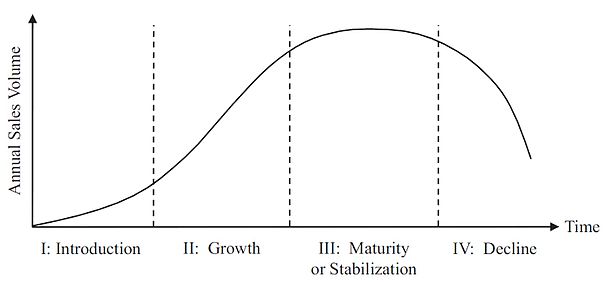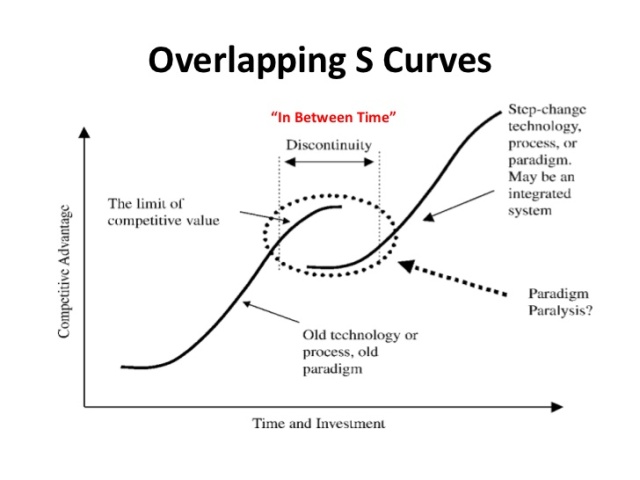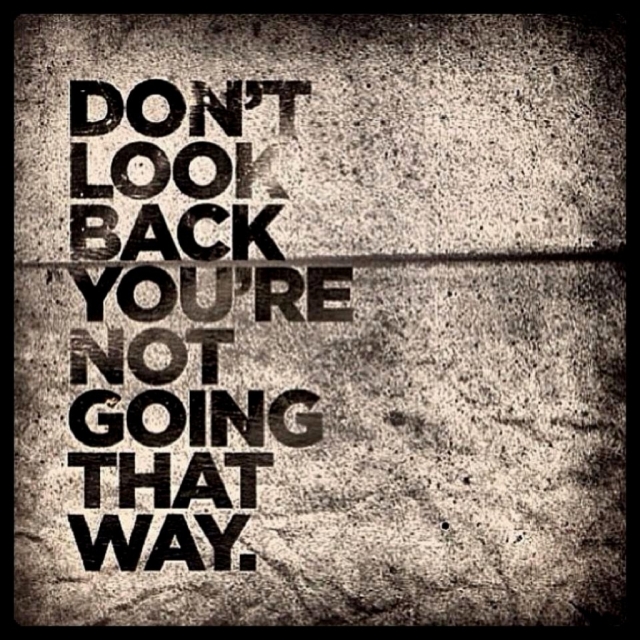
Blog Post By Joe Babaian
Every new beginning comes from some other beginning’s end.
~ Seneca The Elder, 54 BC – 39 AD
Seneca’s quote proved to be so perfect that Semisonic used it to great effect in their popular Closing Time in 1998. This prompts the question I am asking this week: in healthcare technology, processes, and paradigms – when is “closing time” for some established parts of healthcare and time for a new beginning?
Look at this major shift just seen today as shared by Dr. Rasu Shrestha @RasuShrestha – massive consolidation:
A common graph for technology’s life cycle is below. It’s basic and powerful in its implications. For healthcare, we can leave the y-axis as sales volume or swap it to read ROI or even patient outcomes. You get the idea. Over time the technology and processes of healthcare are first new, then grow quickly adding value, soon stabilize and allow us to coast a while enjoying the benefits of known solutions, and then begin to lose their luster as both their value and desired outcomes fade.
This, of course, is a massive oversimplification of the system, but for our chat, this sparks the conversation. One thing missing from this graph is “what’s next?” I’ve never preferred seeing the chart just end at “decline” since that gives no direction and we know things DO go on.
I prefer the “Double S” chart below. In time, every new technology (or process or paradigm) reaches its limit of value and plateaus, or worse, begins to reduce value and patient outcomes. After a break/discontinuity/disruption, something new appears, and the process begins again. In healthcare, the real challenge for all of us is seeing when it’s time to embrace the disruption so that we may not only move forward again but build more value and critically, more of the outcomes we need to see. This cold calculus applies to both the business of healthcare AND the patients. Both suffer when we find ourselves stuck in discontinuity, clinging to outdated, inefficient, no-longer-effective, and stale technology.
Let’s keep this in mind as we think about EHRs for example. We discuss improvements, shifts, changes, and new perspectives but do we talk about “closing time?” Many startups and healthcare change agents are definitely taking many of the lessons we’ve learned and abandoning incremental improvements and jumping into the discontinuity shown above. No promise of success to be sure, but the desire for what’s next is driving them forward.
Clinging to legacy systems and methods is safe, but the future is not in the rear-view mirror nor are the successes and desired outcomes for patients now and in the future. As a note, the “desired outcomes” for patients don’t always mean a “cure” but the entire spectrum of what makes a human whole, respected, empowered, and offered paths that match their needs.

I mentioned EHRs as an illustrative example, and we know the healthcare life cycle covers myriad other features that we consider. Everything from imaging and the rise of #AI / decision support to #MedEd, gene therapy, and hospice.
I knew it would be a great opportunity this week to discuss where we are in various aspects of healthcare’s life cycle, when is “closing time” for many of the parts of healthcare we are comfortable with, and how to get to what’s next! Please join me on Tuesday, September 6th at 8:30pm ET for the weekly #hcldr tweetchat where we will be discussing:
T1: If healthcare follows the traditional life cycle path, what is holding us back from jumping to the next upward surge of real growth and progress resulting from new disruptive innovations?
T2: At what point does incremental innovation become a band-aid that simply refreshes legacy parts of healthcare? How do we know when disruptive change is needed vs just wanting something “new”?
T3: What parts of healthcare have the greatest need for disruptive innovation to break away from our existing systems and paradigms?
T4: Please share examples you’ve seen (or been a part of) in healthcare that successfully jumped from an area of plateau/decline to something disruptive and valuable.
References:
Clark, Tobey, Alexandre Lemgruber, Rossana Rivas, Francisco Caccavo, Tatiana Molina Velasquez, and Javier Comacho. “Virtual Course for the Americas: Healthcare Technology Planning and Management Over the Life Cycle.” In World Congress on Medical Physics and Biomedical Engineering 2018, 325–28. IFMBE Proceedings. Springer, Singapore, 2018. https://doi.org/10.1007/978-981-10-9023-3_58.
Gutiérrez-Ibarluzea, Iñaki, Marco Chiumente, and Hans-Peter Dauben. “The Life Cycle of Health Technologies. Challenges and Ways Forward.” Frontiers in Pharmacology 8 (January 24, 2017). https://doi.org/10.3389/fphar.2017.00014.
“Health Information Technology; What Is the HIT Systems Life Cycle?” //www.nursingcenter.com/journalarticle?Article_ID=1052204&Journal_ID=54021&Issue_ID=1051820.
Shuren, Jeffrey, and Robert M. Califf. “Need for a National Evaluation System for Health Technology.” JAMA 316, no. 11 (September 20, 2016): 1153–54. https://doi.org/10.1001/jama.2016.8708.
Smith, Brian D, Rosanna Tarricone, and Vincenzo Vella. “The Role of Product Life Cycle in Medical Technology Innovation.” Journal of Medical Marketing 13, no. 1 (February 1, 2013): 37–43. https://doi.org/10.1177/1745790413476876.
Photo Credit: Photo by Jeremy Bishop on Unsplash / Unsplash grants you an irrevocable, nonexclusive, worldwide copyright license to download, copy, modify, distribute, perform, and use photos from Unsplash for free, including for commercial purposes, without permission from or attributing the photographer or Unsplash.